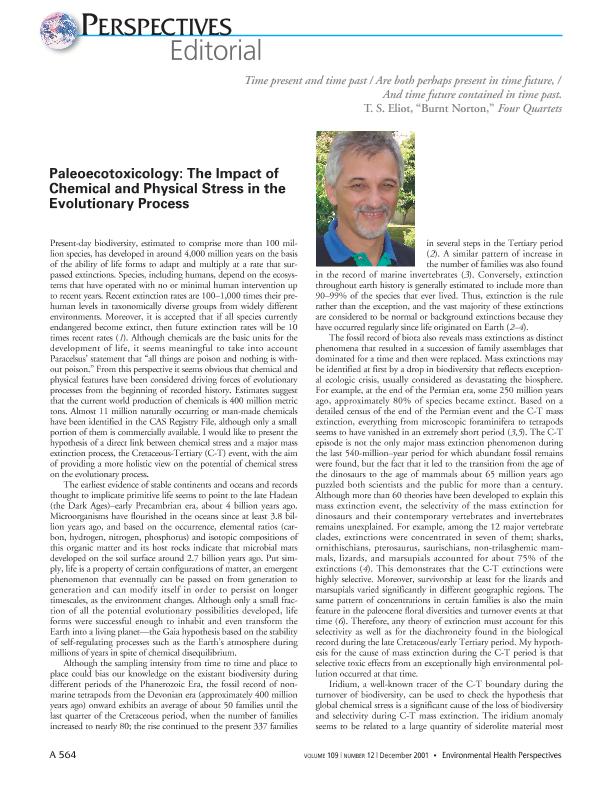Mostrar el registro sencillo del ítem
dc.contributor.author
Herkovits, Jorge

dc.date.available
2022-03-09T23:22:05Z
dc.date.issued
2001-05
dc.identifier.citation
Herkovits, Jorge; Paleoecotoxicology: the impact of chemical and physical stress in the evolutionary process; U.S. Department of Health and Human Sciences. Public Health and Science; Environmental Health Perspectives; 109; 12; 5-2001; 564-566
dc.identifier.issn
0091-6765
dc.identifier.uri
http://hdl.handle.net/11336/153139
dc.description.abstract
Present-day biodiversity, estimated to comprise more than 100 millionspecies, has developed in around 4,000 million years on the basisof the ability of life forms to adapt and multiply at a rate that surpassedextinctions. Species, including humans, depend on the ecosystemsthat have operated with no or minimal human intervention upto recent years. Recent extinction rates are 100–1,000 times their prehumanlevels in taxonomically diverse groups from widely differentenvironments. Moreover, it is accepted that if all species currentlyendangered become extinct, then future extinction rates will be 10times recent rates (1). Although chemicals are the basic units for thedevelopment of life, it seems meaningful to take into accountParacelsus’ statement that “all things are poison and nothing is withoutpoison.” From this perspective it seems obvious that chemical andphysical features have been considered driving forces of evolutionaryprocesses from the beginning of recorded history. Estimates suggestthat the current world production of chemicals is 400 million metrictons. Almost 11 million naturally occurring or man-made chemicalshave been identified in the CAS Registry File, although only a smallportion of them is commercially available. I would like to present thehypothesis of a direct link between chemical stress and a major massextinction process, the Cretaceous-Tertiary (C-T) event, with the aimof providing a more holistic view on the potential of chemical stresson the evolutionary process.
dc.format
application/pdf
dc.language.iso
eng
dc.publisher
U.S. Department of Health and Human Sciences. Public Health and Science

dc.rights
info:eu-repo/semantics/openAccess
dc.rights.uri
https://creativecommons.org/licenses/by-nc-sa/2.5/ar/
dc.subject
ecotoxicology
dc.subject
environmental stress
dc.subject
mass extinction
dc.subject
evolution
dc.subject.classification
Otras Ciencias de la Tierra y relacionadas con el Medio Ambiente

dc.subject.classification
Ciencias de la Tierra y relacionadas con el Medio Ambiente

dc.subject.classification
CIENCIAS NATURALES Y EXACTAS

dc.title
Paleoecotoxicology: the impact of chemical and physical stress in the evolutionary process
dc.type
info:eu-repo/semantics/article
dc.type
info:ar-repo/semantics/artículo
dc.type
info:eu-repo/semantics/publishedVersion
dc.date.updated
2021-12-20T17:25:30Z
dc.journal.volume
109
dc.journal.number
12
dc.journal.pagination
564-566
dc.journal.pais
Estados Unidos

dc.description.fil
Fil: Herkovits, Jorge. Fundación Pro Salud y Medio Ambiente. Instituto de Ciencias Ambientales y Salud; Argentina. Consejo Nacional de Investigaciones Científicas y Técnicas; Argentina
dc.journal.title
Environmental Health Perspectives

dc.relation.alternativeid
info:eu-repo/semantics/altIdentifier/url/https://www.ncbi.nlm.nih.gov/pmc/articles/PMC1240516/
dc.relation.alternativeid
info:eu-repo/semantics/altIdentifier/doi/http://dx.doi.org/10.1289/ehp.109-a564
dc.relation.alternativeid
info:eu-repo/semantics/altIdentifier/url/https://ehp.niehs.nih.gov/doi/10.1289/ehp.109-a564
Archivos asociados
